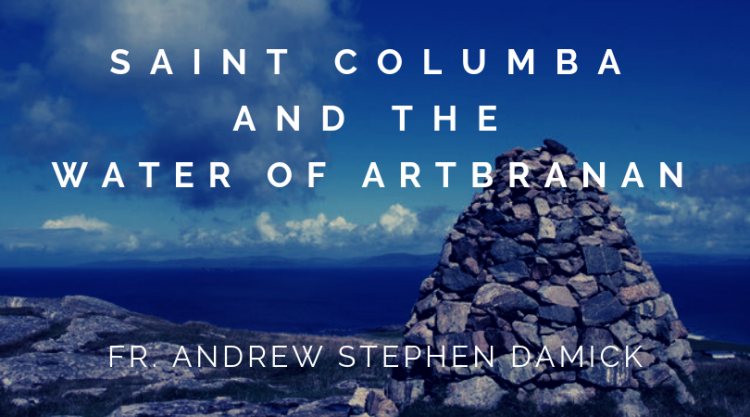
Sunday after Ascension / Feast of St. Columba of Iona, June 9, 2019
Acts 20:16-18, 28-36; John 17:1-13
In the Name of the Father and of the Son and of the Holy Spirit, one God. Amen.
On this ninth day of June, we celebrate the Enlightener of Scotland, an Irish saint named Columba of Iona. Iona is a tiny island off the southwest coast of a larger island called Mull, which is itself off the southwest coast of Scotland. St. Columba’s life is preserved in the telling of another saint of that island, Adomnan of Iona, who was the successor of St. Columba as the abbot of the monastery.
Columba was exiled from his native Ireland after his pride and stubbornness were the cause of a war in which thousands died. He was sent from Ireland by his spiritual father, who told him to journey up the British coast until he found an island from which he could no longer see Ireland. Iona was that little island.
Columba made Iona the site of a famed monastery, and from there, he undertook the evangelism of Scotland, driving out the worship of false gods and spreading the good news of Jesus Christ and His kingdom.
I wish to read to you today a brief excerpt from the Life of St. Columba and then to comment on it for our mutual growth in Christ. The following is from Book I, Chapter 33, and it tells of a visit by St. Columba to one of the other Hebridean islands of Scotland and one of the many prophecies that the saint spoke:
When St Columba was staying for a few days on the island of Skye, he struck with his staff a patch of ground by the seashore in a particular place, and said to his companions:
‘Strange to tell, my dear children, today, here in this place and on this patch of ground, an old man—a pagan but one who has spent his whole life in natural goodness—will receive baptism, and will die and be buried.’
Only an hour later—look!—a little boat came in to land on the shore, bringing in its prow a man worn out with age. He was the chief commander of the warband in the region of Cé. Two young men carried him from the boat and set him down in front of the blessed man. As soon as he had received the word of God from St. Columba, through an interpreter, he believed and was baptized by him. When the rite of baptism was finished, as the saint had predicted, the old man died on the same spot and they buried him there and raised a mound of stones over the place. It is still visible there today by the seashore. The stream in which he had received baptism is even today called by the local people ‘the water of Artbranan’. (Adomnan of Iona, Life of St Columba, tr. Richard Sharpe, pp. 136-7)
The first thing we should notice is how this story begins. St. Columba strikes his staff on the ground near the seashore on the island of Skye. If you are looking at a map of Scotland, this is one of the Inner Hebrides islands, off the northwest coast of Scotland, and quite a distance from Iona. So Columba was clearly on a long voyage when this happened. Skye is about 80 miles north from Iona, which doesn’t seem like a long ways, but if you consider that this is in the sixth century and that the voyage would have been mostly by small boats, that is a considerable distance.
So how should we understand this striking of the ground of Columba with his staff? On the one hand, we could say that he is merely marking the place where this pagan man would receive baptism. But notice that the story ends with a reference to this place, which is now named for the man who was baptized. So it begins and ends with this sense of a particular place.
If we understand this in terms of the Christian encounter with paganism, this makes more sense. The good news of Jesus Christ is not good news only for people but for the whole creation. We see this very clearly at the feast of Theophany, when water is blessed and sent out for the blessing of creation. So when Columba strikes the ground with his staff, he is in a sense claiming territory on behalf of Christ.
And what happens there on that place? A man is baptized, and the place is even then named after him and what happened there. The fact of his baptism changed that place forever, claiming it for Christ and even receiving the name of the man who became a son of the Most High and co-heir with Christ in that place.
The second thing to notice about this story is that St. Columba says about this man that he is “a pagan but one who has spent his whole life in natural goodness.” So he recognizes that there is indeed virtue in this man even though he is not a Christian.
Yet notice that he does not say that he does not need baptism. Rather, there is the sense that his life of “natural goodness” has led him to this point of baptism. He is of great age and even has to be carried to St. Columba by two young men.
And notice that Columba does not simply baptize him on the spot but rather preaches to him the Gospel, which the man received through an interpreter, probably meaning that he was of the Pictish people, who did not speak the same language as the Irish from whom Columba came. And as the text says, the man believed in Jesus Christ.
On this basis, then, he is baptized by St. Columba, and then, as the saint predicted, the man died and was buried on the beach and a cairn—a pile of stones—was raised up on his grave. And then the place became known ever after by what was done there, being called “the water of Artbranan,” named for the baptism of this Pictish warchief who came there to meet Christ in the person of St. Columba.
What should we take away from this story? There are two principles at work here.
First, even someone who is from a violent, pagan people can be recognized as having goodness in him. When Christ comes into the world to save the world, He does so not to erase everything that is present but rather to save and to magnify whatever is good. We should also do the same by recognizing what is good not just in other people but also in ourselves and working to develop that good with an eye toward where it should naturally lead—to fulfillment in Christ and participation in the sacraments and prayers of the Church.
The second principle is this: Christ’s redemption of the world changes not just the people in it but also the whole world itself. The world has been under the dominion of the devil and of the false gods, but with the coming of Christ, this world is being reclaimed and redeemed. And that redemption includes us. The place where Artbranan was baptized not named simply for baptism but for his baptism in particular, being called “the water of Artbranan.” So we participate in the redemption of the creation and even leave our own mark in it.
So let us be like Artbranan, coming to meet Christ and His holiness wherever present, listening to the word of God, believing, and worshiping Christ with all that we have. In that we find the completion and fulfillment of all our lives.
To our Lord Jesus Christ therefore be all glory, honor and worship, with His Father and the Holy Spirit, now and ever, and unto ages of ages. Amen.




Lovely story!! I could see the “good” in St Columba too, because he was given the gift to forsee that something very good was about to happen at that particular place to someone being called by God in receiving Baptism.
Sometimes especially in today’s world, we tend to only see the bad in others and not their potential good – it can be quite a challenge to cause metanoia in another and I think only our prayers and love for the person will please God in sending the Holy Spirit to touch another’s heart to turn it around.
Thankyou for sharing this inspiring story! God bless…..